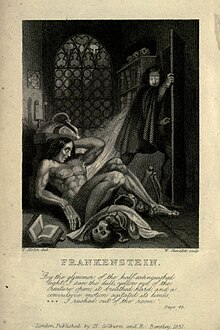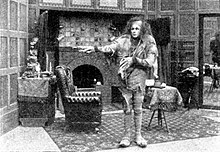Frankenstein's monster
| Frankenstein's monster | |
|---|---|
| Frankenstein: or, The Modern Prometheus character | |
| File:Frontispiece to Frankenstein, 1831.jpg | |
| Created by | Mary Shelley |
| Portrayed by | Charles Ogle, Boris Karloff, many others |
| In-universe information | |
| Nickname | "the monster" |
| Species | human (Gestalt entity) |
| Gender | male |
| Relatives | Victor Frankenstein (creator) |
| Nationality | German (created in Ingolstadt) |
Frankenstein's monster (or Frankenstein's creature) is a fictional character that first appeared in Mary Shelley's novel, Frankenstein, or The Modern Prometheus. In the novel, the creature has no name—a symbol of his parentlessness and lack of human sense of self and identity. He does call himself, when speaking to his creator, Victor Frankenstein, the "Adam of your labours". He is also variously referred to as a "creature," "fiend," "the dæmon," "wretch," "zombie," "devil," "being," and "ogre" in the novel.[1] He is sometimes erroneously referred to as Frankenstein.
The monster's namelessness became part of the stage tradition as Mary Shelley's story was adapted into serious and comic plays in London, Paris, and France during the decades after the novel's first appearance. Mary Shelley herself attended a performance of Presumption, the first successful stage adaptation of her novel. "The play bill amused me extremely, for in the list of dramatic personae came, _______ by Mr T. Cooke,” she wrote her friend Leigh Hunt. “This nameless mode of naming the unnameable is rather good.”[2]
Into this vacuum, it is understandable that the name of the creator—Frankenstein—would soon be used to name the creation. That mistake was made within the first decade after the novel was published, but it became cast in concrete after the story was popularized in the famous 1930s Universal film series starring Boris Karloff. The film was based largely on a play by Peggy Webling, performed in London in 1927.[3] Curiously, Webling's Frankenstein actually does give his creature his name. The Universal film reverted to the empty cypher, however: the film's credits list the character Karloff plays as a series of question marks. Nevertheless, the creature soon enough became best known in the popular imagination as "Frankenstein".
In Shelley's novel

Victor Frankenstein, eldest son of Alphonse and Caroline Beaufort Frankenstein, builds the creature through methods of science (he was a chemistry student at University of Ingolstadt) and alchemy (largely Paracelsus, Albertus Magnus, and Cornelius Agrippa) which are not clearly described. Immediately upon bringing the creature to life, however, Frankenstein flees from it in horror and disavows his experiment. Abandoned, frightened, and completely unaware of who or what he is, the monster wanders through the wilderness searching for someone who would understand and shelter him.
He finds brief solace by hiding out in the wood shed of a remote cottage inhabited by the DeLaceys, a family of peasants. While they are unaware of his existence, he learns every part of their lives by eavesdropping on their conversations; he comes to think of them as his own family, calling them his 'protectors'. He develops the power of speech from listening to the family teach their language to an Arabian daughter-in-law, and very quickly becomes eloquent, educated and well-mannered.
One day, he musters the courage to finally make his presence known. He introduces himself to the family's patriarch, their blind father, and experiences kindness and acceptance for the first (and last) time; the blind man can not see his "accursed ugliness," and so treats him as a friend. When the rest of the family returns, however, they are terrified of the creature, and drive him away. Bewildered but still hopeful, he rescues a peasant girl from a river. A man arrives and shows his gratitude by shooting the creation in the shoulder. Heartbroken, he renounces all of humankind and swears revenge on his creator, Frankenstein, for bringing him into the world.
The monster searches for Frankenstein relentlessly, guided by some papers which were in the pocket of the clothing he took from his creator's rooms. From these he not only discovers Frankenstein's whereabouts, but he also discovers the horrific details of his birth. Upon arriving near Frankenstein's village, he meets and tries to befriend a small boy, William, hoping that the innocent youth will not be prejudiced against him. The boy is instantly frightened and threatens to get his father – Monsieur Frankenstein – and thus the creature learns that the boy is related to his enemy. The creature kills him, and, in a further gesture of hatred against humanity, frames the murder on a girl sleeping nearby by pinning a locket on her person. The girl happens to be the Frankenstein family maid, Justine Moritz. She goes to the gallows because Frankenstein decides it would be futile to confess his experiment, as no one would believe him.
Intent on his own revenge, Frankenstein hunts the creature, and finds him in a remote ice cave. Here the monster tells Frankenstein his story and pleads with him to create a female creature so he can flee from humanity with one of his own kind. Frankenstein agrees, but relents just before finishing the mate, aghast at the possibility of creating a race of monsters. Enraged, the creature swears he will destroy everything Frankenstein holds dear. The creature's final words before fleeing are "I will be with you on your wedding night!"
He makes good on his promise by killing Frankenstein's best friend, Henry Clerval, and his bride, Elizabeth Lavenza. Frankenstein's father, Alphonse, then dies of grief. With nothing left to live for, Frankenstein dedicates his life to hunting his creation down and destroying him. He scours the country, unaware that his creation is stalking his every move. The search ends in the Arctic Circle when Frankenstein loses control of his dogsled and falls into ice cold water, contracting severe pneumonia. He is rescued by a ship exploring the region, and relates the entire story to its captain, Robert Walton, before succumbing to his illness and dying. The creature boards the ship intent on taking his final revenge, but is overcome with grief upon finding Frankenstein dead, having lost the only family he has ever known. He pledges to travel to "the Northernmost extremity of the globe," and there commit suicide. He leaps from the boat and is never seen again.
Appearance

In the novel, the creature is described as being about eight feet (244 centimeters) in height, with translucent yellowish skin that "barely disguised the workings of the vessels and muscles underneath", watery, glowing eyes, flowing black hair, black lips, and white teeth. A picture of the creature appeared in the 1831 edition.
By the time the 1831 edition came out, however, several stage renditions of the story had popularized the monster. Early stage portrayals dressed him in a toga, shaded, along with the monster's skin, a pale blue. Throughout the 19th century, the monster remained a shape shifter, however, as often appearing a classical figure as the animalistic monster we picture today.
In 1910, Thomas Edison's silent film company created a 20-minute adaptation of the story of Frankenstein. His monster (played by Charles Ogle) was wrapped in rags, with exaggeratedly pointed feet and fingers, a wild wig of hair, and boldly open eyes and eyebrows painted in lines reminiscent of a kabuki actor.
The most well-known image of Frankenstein's monster in popular culture derives from Boris Karloff's portrayal in the 1931 movie Frankenstein, with makeup created by Jack Pierce from possibly crucial sketched suggestions by director James Whale (credit for Karloff's look remains controversial). Karloff played the monster in two more Universal films, Bride of Frankenstein and Son of Frankenstein. Lon Chaney, Jr. took over the part from Karloff in The Ghost of Frankenstein, Bela Lugosi portrayed the role in Frankenstein Meets the Wolf Man, and Glenn Strange played the monster in the last three Universal Studios films to feature the character (House of Frankenstein, House of Dracula, and Abbott and Costello Meet Frankenstein), but their makeup replicated the iconic look first worn by Karloff — the image of Karloff's face is owned by his daughter's company, Karloff Enterprises, to this day, which is the reason Universal replaced Karloff's features with Glenn Strange's in most of their marketing.
Personality
As depicted by Shelley, the creature is a sensitive, emotional creature whose only aim is to share his life with another sentient being like himself. The novel portrays him as innately intelligent and literate, having read Paradise Lost, Plutarch's Lives and The Sorrows of Young Werther. He is driven by despair and loneliness to acts of cruelty and murder.
In the 1931 film adaptation, the creature is depicted as mute and beastlike. In the subsequent sequel, Bride of Frankenstein, the creature learns to speak and discover his feelings, though his intelligence and capacity of speech remains limited. These two movies have set standards for most other film portrayals.
In popular culture
The Monster has grown into a symbol for science run amok, black-and-white monster movies, and lumbering brutes with their hands stretched out, among other things, and is now one of the most famous movie characters in history, perhaps the most famous and visually memorable of the Universal Monsters. The Monster's face has become very well known, especially for the electrodes sticking out of his neck, and the square-shaped head. He has starred in numerous films, book spin-offs, games, and has appeared on shirts and lunchboxes. To this day, the Monster is the only true rival for Dracula in terms of fame and reputation.
See also
References
External links
- Frankensteinfilms.com - Comprehensive site on Frankenstein movies, comic books, theatre plays and the original novel
